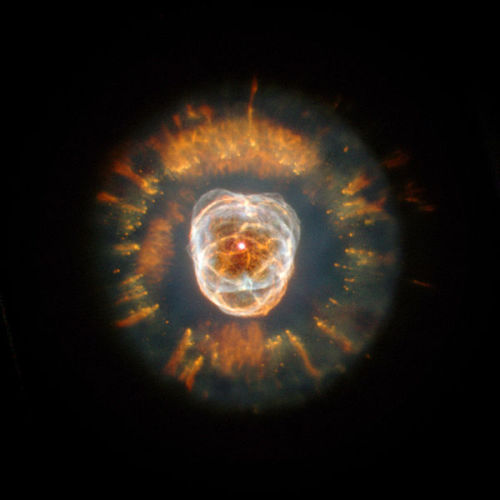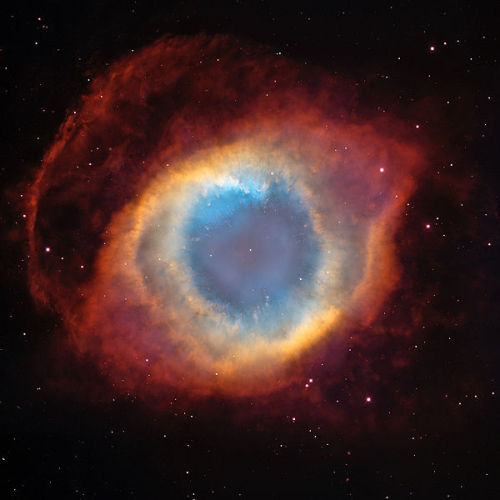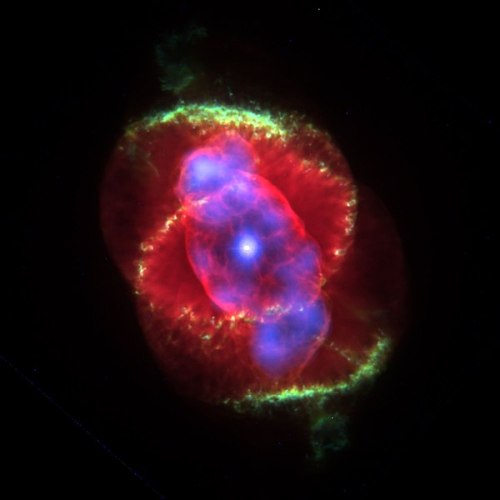🌄🍂🍁🎃🍁🍂
🌄🍂🍁🎃🍁🍂

More Posts from Monstrous-mind and Others


🌌☄️🌃🍂🍁

2024 August 14
Meteors and Aurora over Germany Image Credit & Copyright: Chantal Anders
Explanation: This was an unusual night. For one thing, the night sky of August 11 and 12, earlier this week, occurred near the peak of the annual Perseid Meteor Shower. Therefore, meteors streaked across the dark night as small bits cast off from Comet Swift-Tuttle came crashing into the Earth’s atmosphere. Even more unusually, for central Germany at least, the night sky glowed purple. The red-blue hue was due to aurora caused by an explosion of particles from the Sun a few days before. This auroral storm was so intense that it was seen as far south as Texas and Italy, in Earth’s northern hemisphere. The featured image composite was built from 7 exposures taken over 26 minutes from Ense, Germany. The Perseids occur predictably every August, but auroras visible this far south are more unusual and less predictable.
∞ Source: apod.nasa.gov/apod/ap240814.html

Images of Saturn, Tethys, and Mimas taken by Cassini on July 16 2005.
Credit: NASA/JPL-Caltech/SSI/CICLOPS/Kevin M. Gill
🔭🌃🌌

Alnitak Region with the Horse Head and Flame Nebulae
by Warren Keller

(via 500px / …… by Fabrizio Riccardo Castorina)







Planetary nebula
A planetary nebula, abbreviated as PN or plural PNe, is a kind of emission nebula consisting of an expanding, glowing shell of ionized gas ejected from red giant stars late in their lives. The word “nebula” is Latin for mist or cloud, and the term “planetary nebula” is a misnomer that originated in the 1780s with astronomer William Herschel because, when viewed through his telescope, these objects resemble the rounded shapes of planets. Herschel’s name for these objects was popularly adopted and has not been changed. They are a relatively short-lived phenomenon, lasting a few tens of thousands of years, compared to a typical stellar lifetime of several billion years.
Most planetary nebulae form at the end of the star’s life, during the red giant phase, when the outer layers of the star are expelled by strong stellar winds. After most of the red giant’s atmosphere is dissipated, the ultraviolet radiation of the hot luminous core, called a planetary nebula nucleus (PNN), ionizes the ejected material. Absorbed ultraviolet light energises the shell of nebulous gas around the central star, causing it to appear as a brightly coloured planetary nebula.
Planetary nebulae likely play a crucial role in the chemical evolution of the Milky Way by expelling elements to the interstellar medium from stars where those elements were created. Planetary nebulae are observed in more distant galaxies, yielding useful information about their chemical abundances.
Stars greater than 8 solar masses (M⊙) will likely end their lives in dramatic supernovae explosions, while planetary nebulae seemingly only occur at the end of the lives of intermediate and low mass stars between 0.8 M⊙ to 8.0 M⊙.
source
images: NASA/ESA, Hubble
🔭🪐🌌🌘☄️

2024 June 23
The Colors of Saturn from Cassini Image Credit: NASA, ESA, JPL, ISS, Cassini Imaging Team; Processing & License: Judy Schmidt
Explanation: What creates Saturn’s colors? The featured picture of Saturn only slightly exaggerates what a human would see if hovering close to the giant ringed world. The image was taken in 2005 by the robot Cassini spacecraft that orbited Saturn from 2004 to 2017. Here Saturn’s majestic rings appear directly only as a curved line, appearing brown, in part from its infrared glow. The rings best show their complex structure in the dark shadows they create across the upper part of the planet. The northern hemisphere of Saturn can appear partly blue for the same reason that Earth’s skies can appear blue – molecules in the cloudless portions of both planet’s atmospheres are better at scattering blue light than red. When looking deep into Saturn’s clouds, however, the natural gold hue of Saturn’s clouds becomes dominant. It is not known why southern Saturn does not show the same blue hue – one hypothesis holds that clouds are higher there. It is also not known why some of Saturn’s clouds are colored gold.
∞ Source: apod.nasa.gov/apod/ap240623.html
🍁🍂🎃🍂🍁🍃🐈📚📖☕

🐈🐅

-
 squeakowl reblogged this · 5 months ago
squeakowl reblogged this · 5 months ago -
 jaylynn-von liked this · 5 months ago
jaylynn-von liked this · 5 months ago -
 wired-n-tired liked this · 7 months ago
wired-n-tired liked this · 7 months ago -
 dirtybibli0phile reblogged this · 7 months ago
dirtybibli0phile reblogged this · 7 months ago -
 a-lady-in-red reblogged this · 8 months ago
a-lady-in-red reblogged this · 8 months ago -
 hescores reblogged this · 8 months ago
hescores reblogged this · 8 months ago -
 hescores liked this · 8 months ago
hescores liked this · 8 months ago -
 nokilliwham liked this · 8 months ago
nokilliwham liked this · 8 months ago -
 stillfreeziecat5 reblogged this · 8 months ago
stillfreeziecat5 reblogged this · 8 months ago -
 inspirethemavericks liked this · 8 months ago
inspirethemavericks liked this · 8 months ago -
 dirtybibli0phile reblogged this · 8 months ago
dirtybibli0phile reblogged this · 8 months ago -
 sasquatchthelegend liked this · 8 months ago
sasquatchthelegend liked this · 8 months ago -
 weallfallfromgrace2 reblogged this · 8 months ago
weallfallfromgrace2 reblogged this · 8 months ago -
 grateful4good liked this · 8 months ago
grateful4good liked this · 8 months ago -
 clockswatches reblogged this · 8 months ago
clockswatches reblogged this · 8 months ago -
 gotham-at-nightfall reblogged this · 8 months ago
gotham-at-nightfall reblogged this · 8 months ago -
 aphroditesbox reblogged this · 8 months ago
aphroditesbox reblogged this · 8 months ago -
 synfulsaint reblogged this · 8 months ago
synfulsaint reblogged this · 8 months ago -
 synfulsaint liked this · 8 months ago
synfulsaint liked this · 8 months ago -
 coconutvibe reblogged this · 8 months ago
coconutvibe reblogged this · 8 months ago -
 shes-a-cowboyyy-killer reblogged this · 8 months ago
shes-a-cowboyyy-killer reblogged this · 8 months ago -
 galactic-dragon-pathex liked this · 8 months ago
galactic-dragon-pathex liked this · 8 months ago -
 elizaagain liked this · 8 months ago
elizaagain liked this · 8 months ago -
 abilliondreamsinmyheart reblogged this · 8 months ago
abilliondreamsinmyheart reblogged this · 8 months ago -
 lifelikeweeeds reblogged this · 8 months ago
lifelikeweeeds reblogged this · 8 months ago -
 chill-canadian reblogged this · 8 months ago
chill-canadian reblogged this · 8 months ago -
 chill-canadian liked this · 8 months ago
chill-canadian liked this · 8 months ago -
 that-emo-sexyman liked this · 11 months ago
that-emo-sexyman liked this · 11 months ago -
 bellaboo0505 liked this · 1 year ago
bellaboo0505 liked this · 1 year ago -
 justremainingmyself liked this · 1 year ago
justremainingmyself liked this · 1 year ago -
 super-pupita liked this · 1 year ago
super-pupita liked this · 1 year ago -
 daughter-of-the-rain reblogged this · 1 year ago
daughter-of-the-rain reblogged this · 1 year ago -
 bkelly65 liked this · 1 year ago
bkelly65 liked this · 1 year ago -
 normalisboring-42 liked this · 1 year ago
normalisboring-42 liked this · 1 year ago -
 whirlberry reblogged this · 1 year ago
whirlberry reblogged this · 1 year ago -
 whirlberry liked this · 1 year ago
whirlberry liked this · 1 year ago -
 obsessedwithautumn reblogged this · 1 year ago
obsessedwithautumn reblogged this · 1 year ago -
 itsonlyup reblogged this · 1 year ago
itsonlyup reblogged this · 1 year ago -
 jhenyloirah45 liked this · 1 year ago
jhenyloirah45 liked this · 1 year ago
My ambition is handicapped by laziness. -C. Bukowski Me gustan las personas desesperadas con mentes rotas y destinos rotos. Están llenos de sorpresas y explosiones. -C. Bukowski. I love cats. Born in the early 80's, raised in the 90's. I like Nature, Autumn, books, landscapes, cold days, cloudy Windy days, space, Science, Paleontology, Biology, Astronomy, History, Social Sciences, Drawing, spending the night watching at the stars, Rick & Morty. I'm a lazy ass.
222 posts